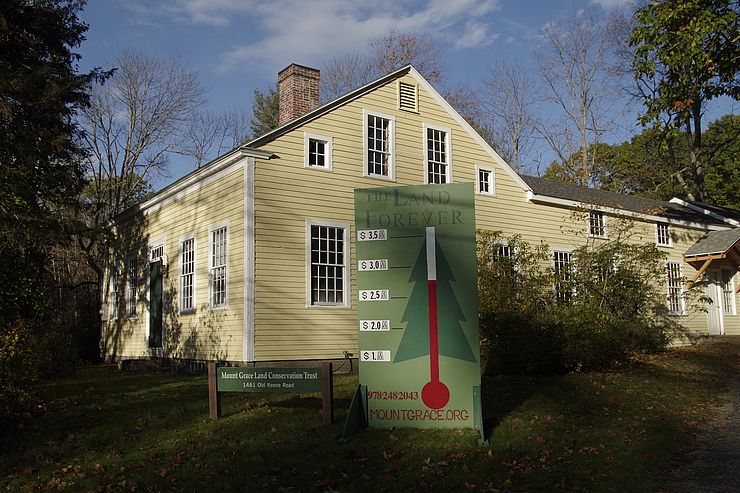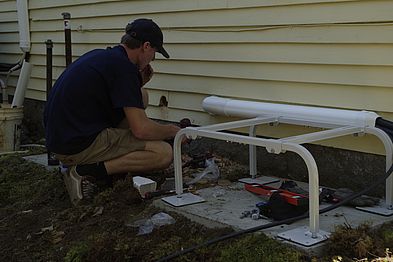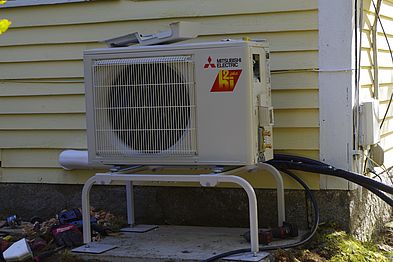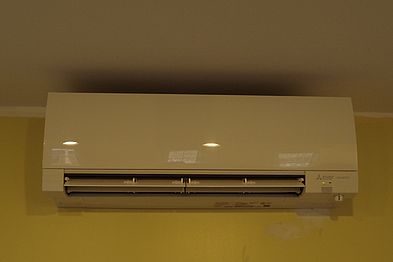Mount Grace Office Renovations
Thanks to the hard work of our building contractors, Mount Grace is nearly finished with the renovations on our office building – a 1790s historical farmhouse. The renovations were two years in the making and were the direct result of the generosity of donors giving to The Land Forever campaign. We budgeted $140,000-$150,000 for all this work. Despite the steep inflation of material costs, it looks like the project will come in on target. We are so happy with the results!
Through the renovations, we sought to create affordable improvements in energy efficiency, while preserving the historic character of the farmhouse. Our building contractors also undertook several safety and aesthetic renovations. For example, they replaced a steep and dangerous staircase, replaced rotten gutters, and painted the outside of the house a cheerful and welcoming yellow.
Why focus on energy efficiency? One reason is comfort – goodbye to winter coats in the Conservation Team room and summer staff meetings in the basement to escape the heat! But a bigger reason is climate change. In 2008, buildings in the U.S. accounted for 40% of the country’s energy use and 8% of the world’s carbon emissions. As conscientious stewards of our land, we want to do our part to reduce our emissions.
Our energy-efficient renovations had four major components: insulation of the basement and attic, energy-efficient windows, a zoned heating and cooling system through mini-splits, and energy-efficient lighting in all the rooms.
Insulation
To make a building airtight, you want to insulate anywhere where air, moisture, or heat could come through. This includes places like around the windows, between the walls, above the building’s foundation, and in the attic. However, the costs need to be balanced with the energy savings.
In Mount Grace’s case, it made sense to add insulation to the basement, attic, and around the windows – but not to the walls. The walls already contained some insulation and insulating them more would have been very costly, with minimal realized energy savings. Given the nearly complete lack of insulation in the basement, we focused there. We used 3” of closed-cell spray foam to insulate the rim joist – part of the building’s frame above the foundation, and a major source of heat loss in many buildings. We also added insulation to the attic. We applied 3” of closed-cell foam on the attic walls and 6.5” of closed-cell foam on the roofline. Attics can account for over 25% of a building’s heat loss, so this was an especially important step. Additionally, closed-cell foam is one of the most effective insulation products on the market. We also added insulation around the windows on both the first and second floors, after replacing them.
Windows and Doors
If you’ve ever sat near a drafty window, you know the importance of having good weatherproof windows. However, the options can be overwhelming.
We considered keeping the old windows and having custom-made plastic inserts, but this would be costly because the old farmhouse windows don’t have straight panes. Ultimately, Mount Grace decided to replace our windows and doors with Pella Impervia windows and doors. Pella has a local branch in Greenfield, MA. The windows are double-paned, with an argon gas layer in between them, providing an extra layer of insulation against the elements. (Triple-paned windows provide even more protection but are much more costly. Because our walls are not completely insulated, triple-paned windows wouldn’t provide a ton of energy savings, either.) The frames are fiberglass, which is generally stronger and more durable than vinyl, offers slightly better insulation, and is often made from recycled glass. The glass has a low-emissivity (low-E) coating, which essentially makes it harder for heat to pass through the window in either direction, making the building more weather-proof.
Heating and Cooling System
Having a “tight building envelope” (good insulation, airtight windows, doors, etc.) is one of the most important parts of an energy-efficient building. (It will also hopefully keep out insect infestations: goodbye ladybugs!) But another crucial element is an energy-efficient heating and cooling system. Whether the system is powered by oil, propane, natural gas, electricity, etc. – and how efficiently it operates – can go miles for reducing emissions.
Before the renovations, Mount Grace used an oil furnace for our main heat source, and in the last couple years, we had window AC units as well. Now, our main heating and cooling source is a series of mini splits, which are electricity-powered heat pumps that provide both heating and cooling. We still have the oil furnace as a backup, because the mini splits do not operate well at very cold temperatures.
Mini splits involve an outdoor unit and an indoor unit, connected by pipes that contain a refrigerant. They are generally more energy-efficient than oil furnaces for a couple of reasons. First, they do not have ducts, which can be a significant source of energy loss. Second, they are always on. In most heating systems, you set the temperature, the system turns on when it’s a couple degrees below that temperature, and then turns off again when it’s a couple degrees above that temperature. But powering the system up each time requires a significant amount of energy. Mini splits don’t waste this energy, and instead keep the temperature of the room tightly controlled.
However, for Mount Grace, the biggest energy savings come from the fact that the mini splits are powered by electricity. Mount Grace is currently on a 100% renewable energy plan through our utility company. When we complete the next phase of our building project, a good portion of the mini splits’ energy use will be generated on-site by a full solar array on our new Conservation Barn!
Lighting
Before the renovations, Mount Grace had lamps in almost every room, which are generally not very energy efficient. Now, Mount Grace has replaced the lighting in three rooms with LED overhead lighting. A thank-you goes out to Mass Saves for consulting with us about energy-efficient lighting options. Mass Saves is a statewide program that helps homes and businesses with energy-efficient building improvements.
Gone are the days of seeing our breath while we work on cold days and melting on the hot ones. Instead, we walk into a beautiful, safe, climate-controlled yellow farmhouse set in one of the most gorgeous regions of Massachusetts, and we have the peace of mind that it is better for the climate, too. A huge thank you to everyone who has made this possible!
For more information on building efficiency and Mount Grace’s renovations, stay tuned for our Building Efficiency Showcase in June. Contact Margaret at thurston@mountgrace.org for more information.




